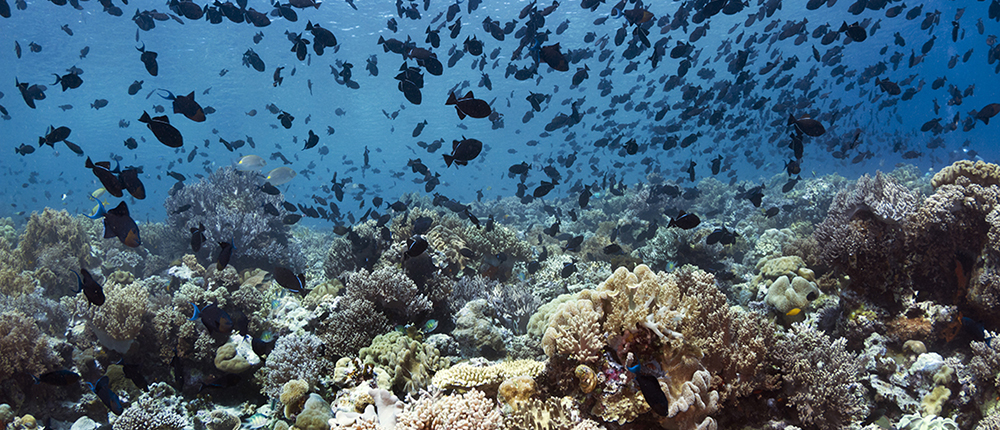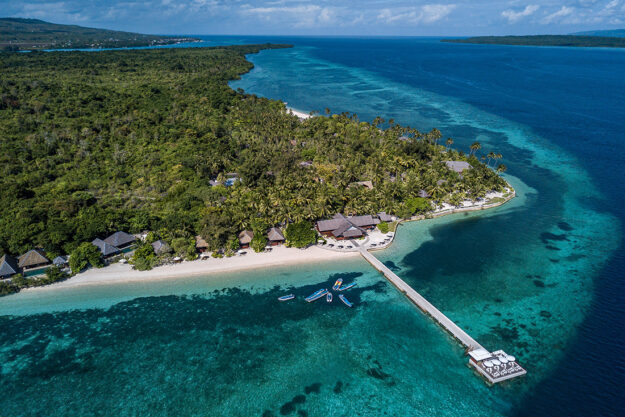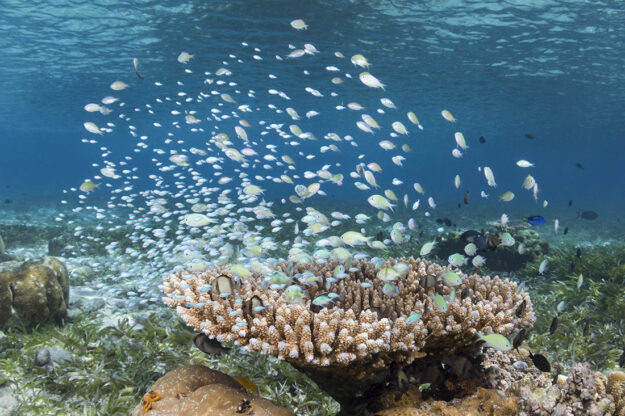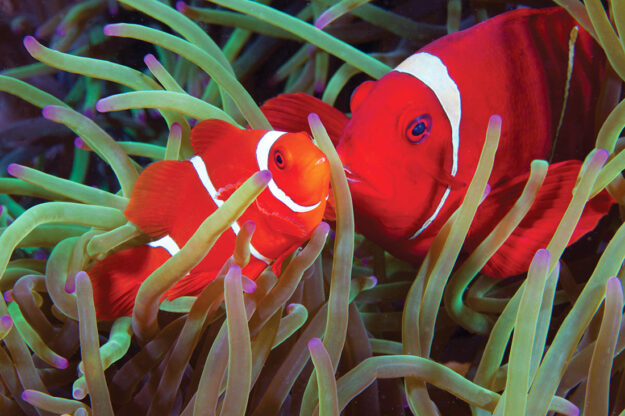Discovering A Shallow Water Paradise
Discover the adventures while snorkeling at Wakatobi
Anticipation builds as the charter flight descends toward Wakatobi Resort’s private airstrip. Through the aircraft’s window, you catch glimpses of a shoreline where coral formations are clearly just below the surface of clear turquoise water. As an avid snorkeler, you treasure those rare destinations where vibrant marine ecosystems lie close to the surface. For years, you’ve read about snorkeling at Wakatobi and the House Reef, which is considered one of the world’s best snorkeling sites.
“Wakatobi is one of the very best places for a diver and snorkeler couple to visit.” ~Tom and Patricia Krise
“There are so many dive sites that are equally great for snorkelers, and the dive team takes care of snorkelers with the same attention and expertise as the divemasters do for the scuba divers,” says Tom and Patricia Krise. “Wakatobi is one of the very best places for a diver and snorkeler couple to visit.”
A Visit to the House
As you settle into your bungalow or villa you can see the vivid aquamarines and blues of the House Reef just beyond the beach. After a light lunch, you stop by the diver center to check in. You now have day-and-night access to the expansive area of reefs and grass beds that extend the length of Wakatobi’s shoreline.
“You could spend days snorkeling on the house reef and have a different experience each time. There are lots of surprises, and so much variety for snorkelers.” ~Yvonne Streit
The Wakatobi House Reef is one of the best sites for long and enjoyable experiences in the shallows. “There are lots of surprises, and so much variety for snorkelers,” says guest Yvonne Streit. “You could spend days snorkeling on the house reef and have a different experience each time. And it is very easy to access. My son and I asked for a taxi boat and we drifted and explored our way back to the jetty. It was a nice long, relaxing afternoon snorkel adventure.”
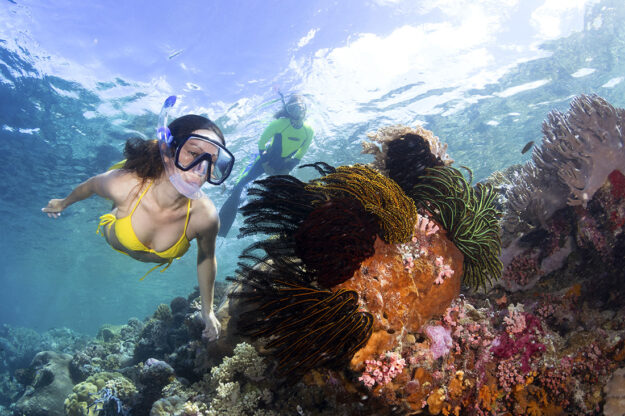
A snorkeler admires a cluster of crinoids on the Wakatobi House Reef while her private snorkel guide watches from the surface. Photo by Walt Stearns
Starting from shore, you fin across a 40-yard expanse of grass-cover shallows punctuated by oases of coral heads. Then suddenly, you are hovering over the edge of the world. You have arrived at the outer edge of the reef, where the coral wall drops abruptly from depths of a meter to more than 40.
You pause to enjoy the silence; there are no phones, no television, no traffic, just sheer beauty. Enjoy this short video featuring snorkeling on the Wakatobi House Reef > here.

At Wakatobi, leaf scorpionfish are often found in the shallow coral recesses at the edge of the house reef drop off, and sometimes in shallows just off the beach, particularly in late afternoon, early evening. Photo by Walt Stearn
Along the reef crest something a bit out of the ordinary catches your eye. A closer look reveals two strange-looking creatures cloistered in a coral recess. Facing each other like a pair of bookends, two Leaf Scorpionfish, each scarcely three inches long, appear to be in the middle of a stare-down contest. You pause to take a quick photo, then move on.
Bright colors jump out from every corner of the reef. Intricately decorated nudibranchs move in slow motion. An alien-looking peacock mantis shrimp emerges from the sand, resplendent in bright colors, and parading around just like the namesake bird itself.
No snorkeling adventure in the Indo-Pacific is complete without seeing Nemo’s family. At least eight species of the famous little cartoon character are found on the House Reef. A pair of false clown anemones nestle into a green anemone while a trio of true clownfish inhabit a nearby carpet anemone. You spot a similar pair but in shades of dark orange and deep maroon. The two are spinecheek anemonefish, named for the large spine on the side of the gill cover. A bit later, you happen upon yet another variety darting madly out from its home in a territorial display. Brilliant orange with a distinct blue tint to its white body bands, this is an orange-finned anemonefish.
“As snorkelers at Wakatobi we saw hundreds of different kinds of fish and coral, and the density, extent and health of the coral was far better than we had seen elsewhere. A real feast for the eyes.” ~Ralph and Renata Muller
On the way back to shore, you realize that a blade of turtle grass is not what it appears to be and is actually a fish mimicking the swaying motion of the seagrass. A closer look reveals a second robust ghost pipefish drifting side by side with its hunting partner. After snapping a few shots and observing the well-camouflaged pair you are eager to share your discovery. After all, where else could you spot these rare creatures just a few feet from the surface?
A few hours and an excellent dinner later, it’s time to see another side of the House Reef. This time, you enter from the stairs of the resort jetty. A sweep of the dive light shows something about the size of a dinner plate skirting across the sand. It’s a blue-spotted stingray with a telltale collection of iridescent blue spots dotting its back. Finning towards the grass beds, you spy a small octopus out on its nighttime foraging. Shining a light on this cephalopod triggers a game of peek-a-boo as the little guy quickly vanishes and then reappears amongst the green and brown seagrass blades.
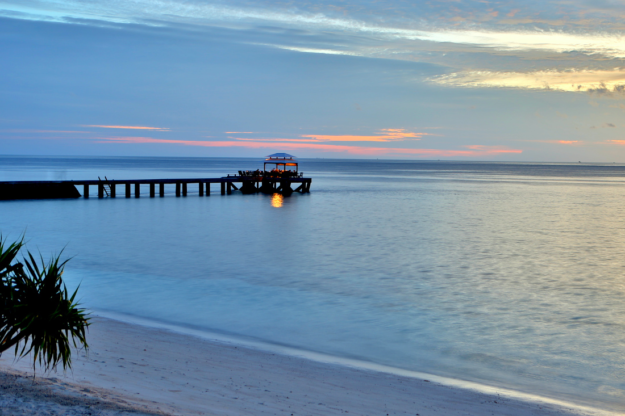
Many guests like to enjoy a sunset snorkel around the jetty and along the drop off. Photo by Wakatobi Dive Resort
Under the cover of night, eels emerge from hidden crevices, and squid flit in and out of the shadows created by your light. Scorpionfish become more active, and flatworms emerge from burrows to feed. The light beam catches an unexpected reflection on a purplish lump. It’s a frogfish, perfectly camouflaged to mimic the colors and patterns of a sponge. You’d probably have missed it in daylight hours. The next half hour yields a collection of pipefish, mantis shrimp, leaf fish, and a funky hairy squat lobster. Though present during daylight hours, many of these animals are easier to spot when illuminated by the beam of a dive light.


